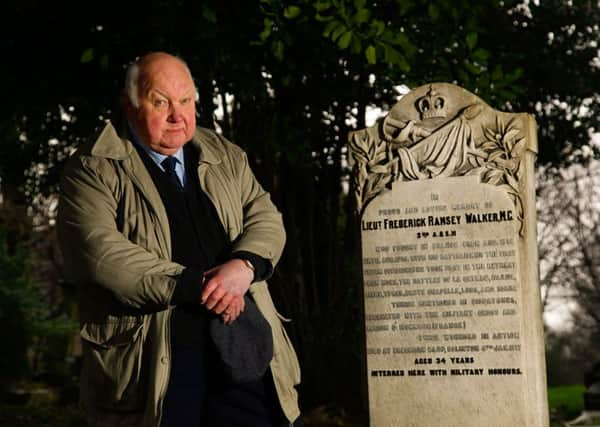WWI Soldier's ruined grave fixed by mystery volunteer


But when an amateur military historian who intended fundraising to restore the headstone of Lieutenant Frederick Ramsey Walker, of the 2nd battalion of the Argyll and Sutherland Highlanders, in Dalry cemetery, revisited the grave, he discovered it had been fully restored – but no-one could tell him who was responsible.
Now, with the 100th anniversary of Lt Walker’s death falling today, history buff Edward Flint, a retired civil servant from Edinburgh, wants to uncover the identity of the benefactor who restored the headstone to its former glory.
Advertisement
Hide AdAdvertisement
Hide AdLt Walker who was born in Tipperary, in Ireland, joined the army when he was 13 years old. He died suddenly at Dreghorn camp, in Colinton, aged 34.
When he died, The Evening Despatch on January 10, 1917 reported that “a large number of people accompanied the cortege from camp to cemetery, preceded by pipe and brass bands of his battalion and followed by 600 men from different battalions. There was a graveside service, and shots were fired.”
Mr Flint said he first spotted the headstone five years ago when researching the background of thousands of men from Gorgie and Dalry who had been killed in the Great War.
He said: “Frederick Walker’s stone was quite unique. It was ornate and on the inscription it said he had been awarded the Military Cross and Legion De Honneur. It listed all his battles – the retreat from Mons, and battles of Le Cateau, Marne, Aisne, Ypres, Neuve Chapelle, Loos and the Somme. He had also been wounded twice in action and mentioned three times in despatches.
Advertisement
Hide AdAdvertisement
Hide Ad“The Legion of Honour was said to have been presented to him personally by General Joffre.” He added: “But the headstone had fallen and was fragmented, it was just rubble. I had no prior knowledge of the man or how it was he had been laid in that ground, but felt that he deserved better than to have his grave fall to neglect.”
In 2014, Mr Flint spoke to members of the Gorgie Memorial Hall about fundraising and returned to the graveyard to give an exact location.
He said: “The graveyard had been tidied up by volunteers and at first I couldn’t find it. But there it was, fully restored. I was totally baffled. It is a complete mystery. Another strange thing was that when I re-examined a photo of the stone there was a small glass containing the remnants of a candle and a penny which had been left at the base of the stone.
“I contacted the War Graves Commission but they said they hadn’t been involved with the restoration. My aim now is to find out who restored the stone and say ‘well done’ to them.”
Advertisement
Hide AdAdvertisement
Hide AdLt Walker’s name also appears on the Church of Ireland Roll of Honour, and on one of the Carillon Bells at Loughborough’s Memorial Tower with the inscription “The Gift of William and Ellen Johnstone in memory of Lt Frederick Ramsay Walker”.